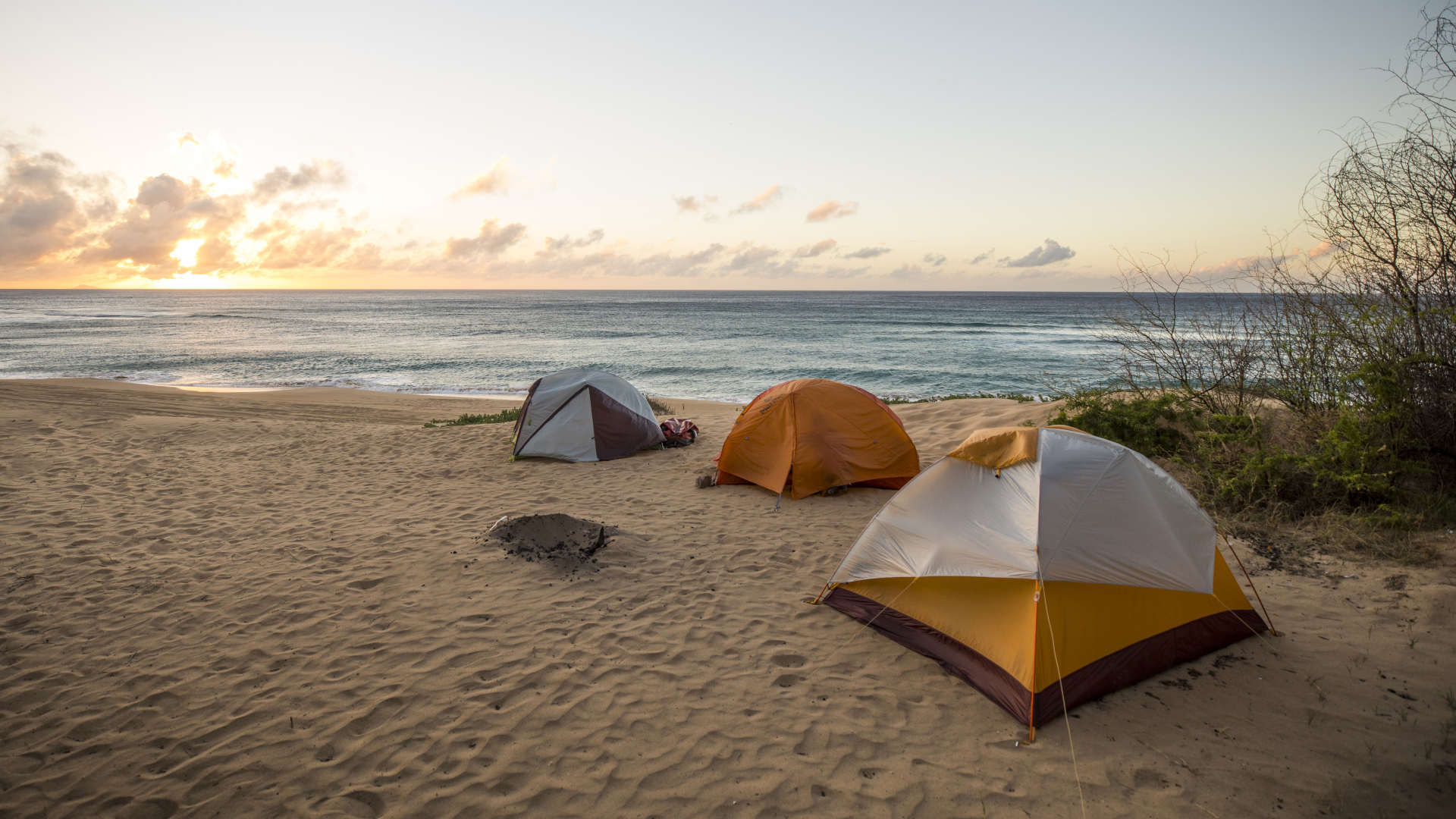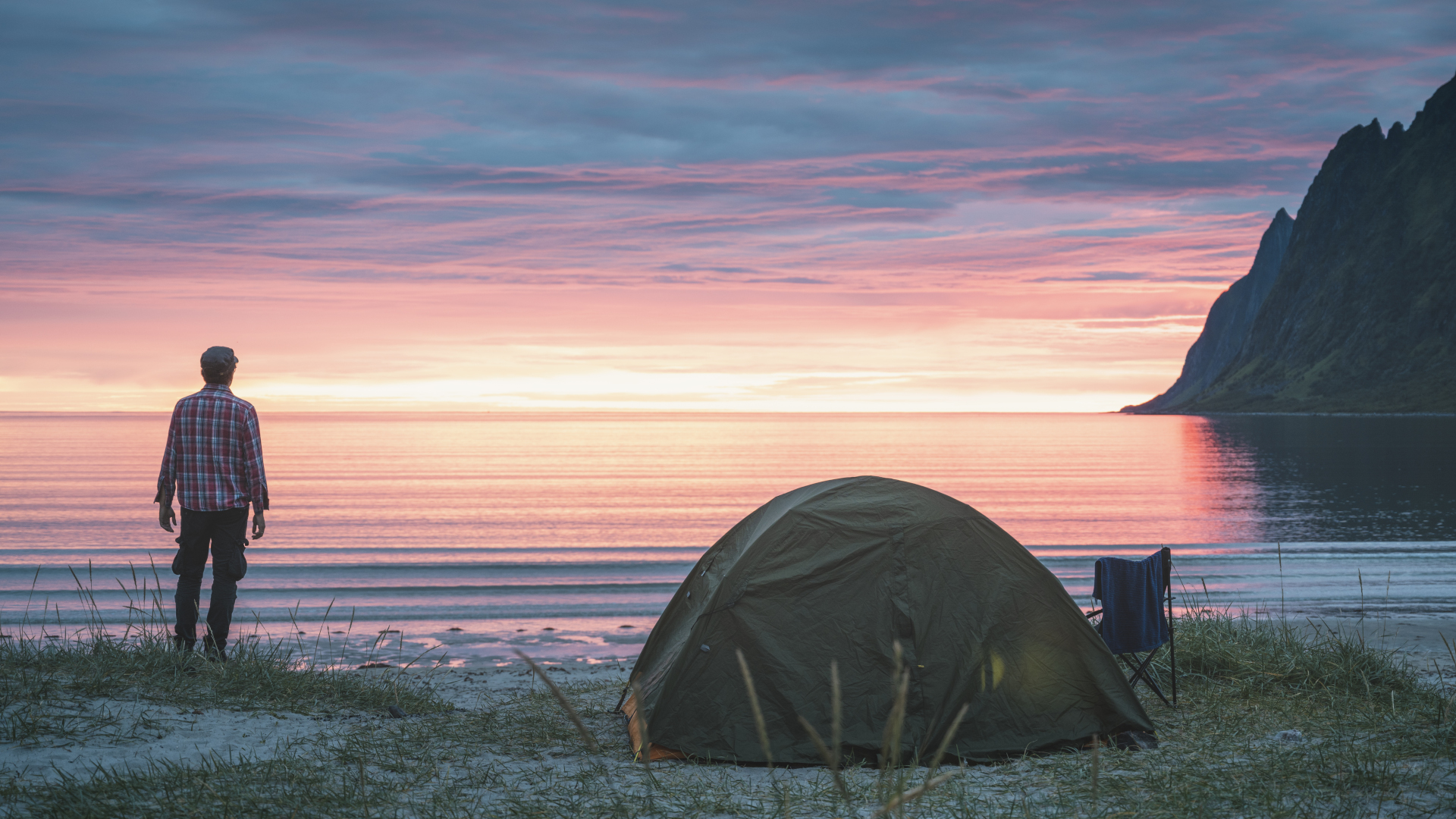10 best beach camping tips for coastal capers
Our beach camping tips cover hacks for pitching your tent in the sand, avoiding high tide and overcoming breezy conditions

There are lots of great reasons to go beach camping – there’s the fresh sea breeze, the sound of the waves to lull you to sleep, you can go wild swimming, surfing or challenge yourself by running on the sand. Plus, if there’s a good breeze, you might escape the mosquitos that love to hover around lakes and rivers where you like to camp. But you can also expect more variables than you might get when you’re camping in the woods, from softer, more unstable ground on which to pitch your tent to changing tides and sand everywhere. Our beach camping tips have you covered so you know just what extra items you need to bring for comfort and where to pitch your tent for safety.
Beach camping tips

1. Buy tent stakes for sand
Any tent will do for beach camping, but even a good set of regular tent stakes won’t do you much good in the sand, so get yourself a set (or two) that are specifically designed for camping in sand to anchor your shelter down against that sea breeze.
2. Plan for wind
Coastal regions do tend to be windier than inland areas, so you’ll want to read our article on camping in the wind to prepare and know how to pitch your tent if winds are higher than usual.
3. Understand the tides
If you arrive when the tide is out, the beach will be huge but that doesn’t mean you can pitch your tent just anywhere. Get it wrong and you’ll wake up in the middle of the night with the waves lapping at your toes. Read our article on how to read tide charts and find out when high and low tide occur on the beach you’re visiting. When you arrive, you should be able to determine the high tide mark by a line of seaweed or driftwood – pitch your tent above that line.

4. Stay out of the dunes
Though you want to camp high up away from the high tide line, don’t be tempted to pitch your tent up in the sand dunes. Sand dunes are home to diverse plant and animal species that don’t want to be trampled which is why you’ll often see signs telling you to keep off the sand dunes. On many beaches, camping in the sand dunes is explicitly prohibited.
5. Pack a tarp – or two
There are countless good uses for a tarp at the beach. First, you’re unlikely to have the shade of tree coverage that you’re used to in the woods, so you can use it to set up shelter from the sun. If it’s breezy at the beach, you can also use your best camping tarp to create a windbreak. And placing a tarp on the ground under your tent gives you an area to stand on and brush the sand off your feet before getting into your tent.
6. Don’t count on comfort
Sand seems nice and soft when you sit on it, but when you lie down it can be bumpy and worse still, not all beaches are sandy. Don’t be fooled into thinking you can leave your sleeping pad at home, and if you are camping on sand, make sure you smooth it down before pitching your tent.
All the latest inspiration, tips and guides to help you plan your next Advnture!

7. Bring a dustpan and bucket
Speaking of sand into your tent, bring a small dustpan and brush so you can sweep out the tent regularly. You can also bring a camping bucket, fill it with sea water and keep it outside your tent so you can wash your feet before entering your tent.
8. Dig a fire pit – and bring firewood
If you’re allowed to build a campfire, unless you know there’s a lot of driftwood on the beach or woodlands nearby, you’ll want to bring your own firewood. To build your fire, dig a fire pit in the sand to give it some extra protection from the breeze. At the end of the evening, douse your fire thoroughly in sea water. Be aware that the sand surrounding your fire can become poker hot, so don't walk close to it in bare feet.

9. Bring extra sun protection
Though all types of camping can involve lots of sun exposure, beach camping means little or no shade and the UV rays reflecting off the water. Even if you have a tarp shelter, bring sunscreen with a high SPF and wear a sun hat and sunglasses.
10. Pack your water shoes
There’s perhaps no better piece of kit than your best water shoes when it comes to beach camping. Good water shoes give you grip on slick underwater surfaces and protect your feet from sharp shells and rocks so you can splash around and enjoy yourself.
Julia Clarke is a staff writer for Advnture.com and the author of the book Restorative Yoga for Beginners. She loves to explore mountains on foot, bike, skis and belay and then recover on the the yoga mat. Julia graduated with a degree in journalism in 2004 and spent eight years working as a radio presenter in Kansas City, Vermont, Boston and New York City before discovering the joys of the Rocky Mountains. She then detoured west to Colorado and enjoyed 11 years teaching yoga in Vail before returning to her hometown of Glasgow, Scotland in 2020 to focus on family and writing.

